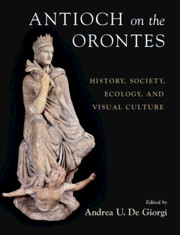Book contents
- Antioch on the Orontes
- Antioch on the Orontes
- Copyright page
- Dedication
- Contents
- Plates
- Figures
- Tables
- Contributors
- Abbreviations
- Antioch on the Orontes
- Part I Beginnings
- Chapter 1 The History of Antioch
- Chapter 2 The Geomorphology of the Greater Antioch Region
- Chapter 3 Seleucid Antioch
- Chapter 4 Seleucia Pieria in the Seleucid Period
- Chapter 5 The Antioch Mint
- Chapter 6 Antioch and Its Hellenistic Monuments
- Chapter 7 Antioch’s Visual Culture and Its Hellenistic Past
- Part II The Making of a Capital
- Part III The People of Antioch
- Part IV Religion
- Part V Crises and Resilience
- Index
- Plate Section
- References
Chapter 1 - The History of Antioch
Written Sources: A Survey
from Part I - Beginnings
Published online by Cambridge University Press: aN Invalid Date NaN
- Antioch on the Orontes
- Antioch on the Orontes
- Copyright page
- Dedication
- Contents
- Plates
- Figures
- Tables
- Contributors
- Abbreviations
- Antioch on the Orontes
- Part I Beginnings
- Chapter 1 The History of Antioch
- Chapter 2 The Geomorphology of the Greater Antioch Region
- Chapter 3 Seleucid Antioch
- Chapter 4 Seleucia Pieria in the Seleucid Period
- Chapter 5 The Antioch Mint
- Chapter 6 Antioch and Its Hellenistic Monuments
- Chapter 7 Antioch’s Visual Culture and Its Hellenistic Past
- Part II The Making of a Capital
- Part III The People of Antioch
- Part IV Religion
- Part V Crises and Resilience
- Index
- Plate Section
- References
Summary
A systematic review of the Classical, Late Antique, and Byzantine sources that underpin the study of Antioch.
Keywords
- Type
- Chapter
- Information
- Antioch on the OrontesHistory, Society, Ecology, and Visual Culture, pp. 9 - 21Publisher: Cambridge University PressPrint publication year: 2024



